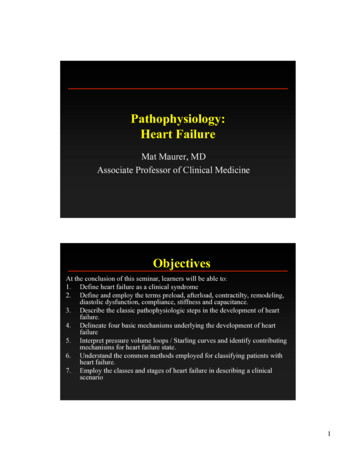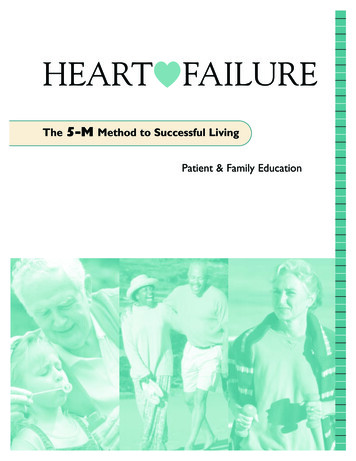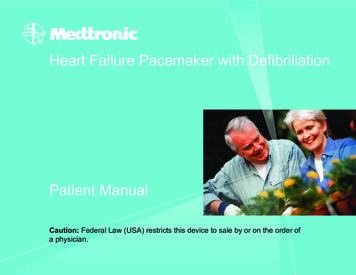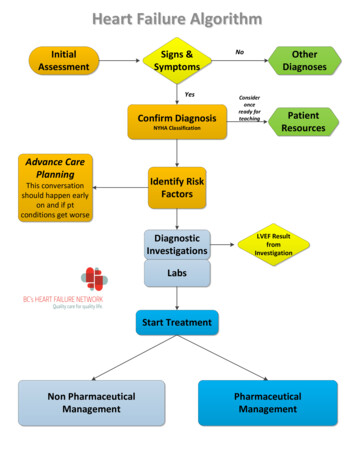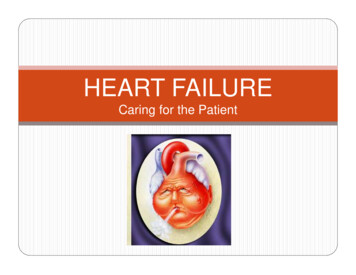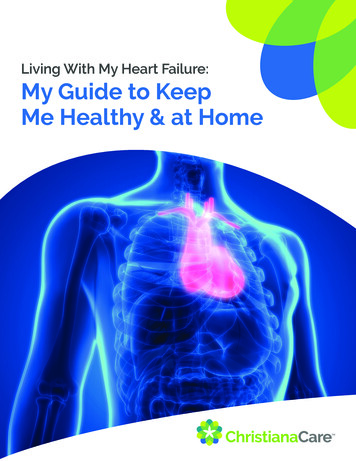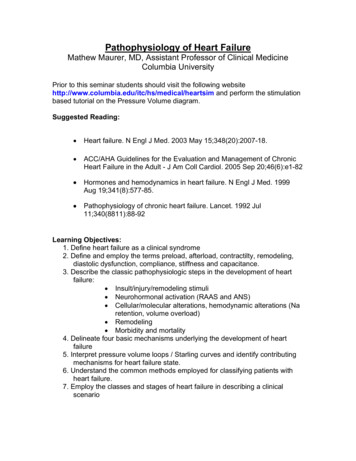
Transcription
Pathophysiology of Heart FailureMathew Maurer, MD, Assistant Professor of Clinical MedicineColumbia UniversityPrior to this seminar students should visit the following tsim and perform the stimulationbased tutorial on the Pressure Volume diagram.Suggested Reading: Heart failure. N Engl J Med. 2003 May 15;348(20):2007-18. ACC/AHA Guidelines for the Evaluation and Management of ChronicHeart Failure in the Adult - J Am Coll Cardiol. 2005 Sep 20;46(6):e1-82 Hormones and hemodynamics in heart failure. N Engl J Med. 1999Aug 19;341(8):577-85. Pathophysiology of chronic heart failure. Lancet. 1992 Jul11;340(8811):88-92Learning Objectives:1. Define heart failure as a clinical syndrome2. Define and employ the terms preload, afterload, contractilty, remodeling,diastolic dysfunction, compliance, stiffness and capacitance.3. Describe the classic pathophysiologic steps in the development of heartfailure: Insult/injury/remodeling stimuli Neurohormonal activation (RAAS and ANS) Cellular/molecular alterations, hemodynamic alterations (Naretention, volume overload) Remodeling Morbidity and mortality4. Delineate four basic mechanisms underlying the development of heartfailure5. Interpret pressure volume loops / Starling curves and identify contributingmechanisms for heart failure state.6. Understand the common methods employed for classifying patients withheart failure.7. Employ the classes and stages of heart failure in describing a clinicalscenario
I. Definitions - Not a disease but rather a syndrome, with diverse etiologiesand several mechanismsA. An inability of the heart to pump blood at a sufficient rate to meet themetabolic demands of the body (e.g. oxygen and cell nutrients) at restand during effort or to do so only if the cardiac filling pressures areabnormally high.B. A complex clinical syndrome characterized by abnormalities in cardiacfunction and neurohormonal regulation, which are accompanied byeffort intolerance, fluid retention and a reduced longevityC. A complex clinical syndrome that can result from any structural orfunctional cardiac disorder that impairs the ability of the ventricle to fillwith or eject blood.II. Epidemiology in United StatesA. Prevalence: 3.5 million in 1991, 4.7 million in 2000, estimated 10million by 2037, currently 5 million patients diagnosed withsymptomatic HF.B. Age dependent prevalence: 1% ages 50--59, 10% over age 80C. Incidence: annually there are 550,000 new cases of symptomatic HFdiagnosedD. 15 million outpatient visits for heart failure per year in U.S.E. 1 million hospitalizations and 6.5 million hospital days for heart failureF. 2.6 million patients hospitalized with heart failure as a 2 diagnosisG. 33% of patients with heart failure as a discharge diagnosis readmittedwithin 90 daysH. 24 billion annually on heart failure in the USI. More deaths from HF than from all forms of cancer combinedJ. Most common cause for hospitalization in age 65 (e.g. MedicarePopulation)III. Heart Failure ParadigmsA. A paradigm is a conceptual or methodological model underlying thetheories and practices of a science or discipline at a particular time;(hence) a generally accepted world view.B. The cardiorenal model was favored in the 1950-1960s when heartfailure was predominately an edematous state. This era led to theadvent of diuretics and digoxin.C. The hemodynamic model was the predominant paradigm from the1970s through the early 1980s, was focused on the tools available atthe time including measures of intra-cardiac pressures and flow. This
paradigm forms the basis for our understanding of heart failure as ahemodynamic disorder and remains a principle method in which weteach the pathophysiology of the syndrome. These first two paradigmshave now been largely abandoned in clinical practice of themanagement of patients with chronic heart failure (e.g. outpatients)and are employed in specifically in for the management ofdecompensated patients in the hospital, where positive inotropic drugsand vasodilators are still widely used.D. The neurohormonal hypothesis forms the basis for the moderntreatment of chronic heart failure. This paradigm focuses on theneuroendocrine activation that results after the initial insult or stimuliand has been shown chronically to be important in the progression ofheart failure. Inhibition of neurohormones has been demonstrated tohave long-term benefit with regard to morbidity and mortality and haverevolutionized the treatment for chronic heart failure.E. Genetic model is on the horizon and will employ newer genetic testingto further characterize the underlying mechanism, develop novel butmore targeted therapies, define the natural history of the disease aswell as the response to pharamaco-therapy (e.g. pharmacogenomics).Indeed a new classification system has been proposed forcardiomyopathies that is based specifically on genetic etiologies(Circulation. 2006 Apr 11;113(14):1807-16).IV. Basic Cardiovascular ParametersA. The heart is a muscular pump connected to the systemic andpulmonary vascular systems. Working together, the principle job of theheart and vasculature is to maintain an adequate supply of nutrients inthe form of oxygenated blood and metabolic substrates to all of thetissues of the body under a wide range of conditions. In order tounderstand the heart as a muscular pump and of the interactionbetween the heart and the vasculature and how this can becomedisordered, the concepts of contractility, preload and afterload areparamount.B. The ability of the ventricles to generate blood flow and pressure isderived from the ability of individual myocytes to shorten and generateforce. Myocytes are tubular structures. During contraction, the musclesdoes one of two actions, it either shortens and/or generate force.C. One can isolate a piece of muscle from the heart, hold the ends andmeasuring the force developed at different muscle lengths whilepreventing muscles from shortening (e.g. isometric contractions). Asthe muscle is stretched from its slack length (the length at which noforce is generated), both the resting (end-diastolic) force and the peak(end-systolic) force increase. The end-diastolic (passive) force-lengthrelationship (EDFLR) is nonlinear, exhibiting a shallow slope at low
lengths and a steeper slope at higher lengths which reflects thenonlinear mechanical restraints imposed by the sarcolemma andextracellular matrix that prevent overstretch of the sarcomeres (seefigure below and EDFLR in green). End-systolic (peak activated) forceincreases with increasing muscle length to a much greater degree thandoes end-diastolic force. End-systolic force decreases to zero at theslack length, which is generally 70% of the length at which maximumforce is generated. The difference in force at any given muscle lengthbetween the end-diastolic and end-systolic relations increases asmuscle length increases, indicating a greater amount of developedforce as the muscle is stretched. This fundamental property of cardiacmuscle is referred to as the Frank-Starling Law of the Heart inrecognition of its two discoverers.D. Frank Starling law of the heart delineates that with increasing lengthof the sarcomere, myocytes or cardiac muscle fibers there is anincreasing force generated. The length of a cardiac muscle fiberprior to the onset of contraction or the volume of the left ventricleprior to the onset of contraction is a measure of cardiac preload.For the ventricle, there are several possible measures of preload: 1)EDP, 2) EDV, 3) wall stress at end-diastole and 4) end-diastolicsarcomere length. Sarcomere length probably provides the mostmeaningful measure of muscle preload, but this is not possible tomeasure in the intact heart. In the clinical setting, EDP probablyprovides the most meaningful measure of preload in the ventricle. EDPcan be assessed clinically by measuring the pulmonary capillarywedge pressure (PCWP) using a Swan-Ganz catheter that is placedthrough the right ventricle into the pulmonary artery.
E. Afterload is the load imposed on the ventricle during ejection.This load is usually imposed on the heart by the arterial system, butunder pathologic conditions when either the mitral valve is incompetent(i.e., leaky) or the aortic valve is stenotic (i.e., constricted) afterload isdetermined by factors other than the properties of the arterial system.There are several measures of afterload that are used in differentsettings (clinical versus basic science settings). Four differentmeasures of afterload include:1. Aortic Pressure. This provides a measure of the pressure thatthe ventricle must overcome to eject blood. It is simple to measure,but has several shortcomings. First, aortic pressure is not aconstant during ejection. Thus, many people use the mean valuewhen considering this as the measure of afterload. Second, aorticpressure is determined by properties of both the arterial system andof the ventricle. For example, if one increases contractility andincreases cardiac output, aortic pressure will increase. Thus, meanaortic pressure is not a measure which uniquely indexes arterialsystem properties.2. Total Peripheral Resistance. The total peripheral resistance(TPR) is the ratio between the mean pressure drop across thearterial system [which is equal to the mean aortic pressure (MAP)minus the central venous pressure (CVP)] and mean flow into thearterial system [which is equal to the cardiac output (CO)]. Unlikeaortic pressure by itself, this measure is independent of thefunctioning of the ventricle. Therefore, it is an index whichdescribes arterial properties. According to its mathematicaldefinition, it can only be used to relate mean flows and pressuresthrough the arterial system.3. Arterial Impedance. This is an analysis of the relationshipbetween pulsatile flow and pressure waves in the arterial system. Itis based on the theories of Fourier analysis in which flow andpressure waves are decomposed into their harmonic componentsand the ratio between the magnitudes of pressure and flow wavesare determined on a harmonic-by-harmonic basis. Thus, insimplistic terms, impedance provides a measure of resistance atdifferent driving frequencies. Unlike TPR, impedance allows one torelate instantaneous pressure and flow. It is more difficult tounderstand, most difficult to measure, but the most comprehensivedescription of the intrinsic properties of the arterial system as theypertain to understanding the influence of afterload on ventricularperformance. It is used primarily in research settings.4. Myocardial Peak Wall Stress. During systole, the musclecontracts and generates force, which is transduced intointraventricular pressure, the amount of pressure being dependent
upon the amount of muscle and the geometry of the chamber. Bydefinition, wall stress (σ) is the force per unit cross sectional area ofmuscle and is simplistically interrelated to intraventricular pressure(LVP) using Laplace’s law: σ LVP*r/h, where r is the internalradius of curvature of the chamber and h is the wall thickness. Interms of the muscle performance, the peak wall stress relates tothe amount of force and work the muscle does during a contraction.Therefore, peak wall stress is sometimes used as an index ofafterload. While this is a valid approach when trying to explainforces experienced by muscles within the wall of the ventricularchamber, wall stress is mathematically linked to aortic pressurewhich, as discussed above, does not provide a measure of thearterial properties and therefore is not useful within the context ofindexing the afterload of the ventricular chamber.F. Contractility is the force of contraction independent of preloadand afterload. If a drug is administered which increases the amount ofcalcium released to the myofilaments (for example epinephrine, whichbelongs to a class called inotropic agents), the end-systolic forcelength relationship (ESFLR) will be shifted upwards, indicating that atany given length the muscle can generate more force. Conversely,negative inotropic agents generally decrease the amount of calciumreleased to the myofilaments and shift the ESFLR downward. Inotropicagents typically do not affect the end-diastolic force-length relationship.V. Ventricular-Vascular Coupling Analyzed on the Pressure-VolumeDiagramA. Pressure Volume Paradigm1. Basic parameters of the PV loopa) During a single cardiac cycle the heart contractsisovolumetrically (points A to B), then ejects blood (points Bto C), isovolumetrically relaxes (points C to D) and thenpassively fills (point D to A) as depicted in the diagrambelow. Systole is the time between points A to C and
diastole between C to A.B. Various parameters can be derived from the PV loop as shown below.In general the heart in its role as a hemodynamic pump has two roles:1. To move blood (e.g. generate a stroke volume, which is thedifference between the end diastolic volume [EDV] and the endsystolic volume [ESV].2. To generate pressure, (e.g. the difference between the EDP andthe systolic blood pressure is the pressure generated by the leftventricle).3.4.PressureGeneration5.
3. The area of the pressure volume loop is a representation of thework that the ventricle is able to do and is called the stroke work,which can be estimated as the stroke volume time the differencebetween SBP and LVEDP.C. ESPVR and EDPVR1. If one were to place a balloon in the inferior vena cava or aclamp on the inferior vena cava and inflate the balloon or tightenthe clamp, venous return would decline and the pressures andvolumes of the left ventricle would decline, as shown below.2. Connecting the end systolic and end-diastolic pressure volumepoints delineates two measure of ventricular function the ESPVRwhich is a measure of left ventricular chamber contractility and theEDPVR which is a measure of ventricular filling.3. The ESPVR is a measure of chamber contractility, which isdetermined both by its slope and it relative position on the pressurevolume plane. For example, one can increase of decreasecontractility by administering a positive inotropic agent (e.g.dobutamine) which will shift the ESPVR upward. At any givenvolume of the ventricle with the higher ESPVR (shown in blue) willgenerate more pressure than the ventricle with the normalcontractility (shown in green) and is therefore considered to be“stronger”. Alternatively one can shift the ESPVR downward (shownin red) as occurs with an insult such as a myocardial infarction andthe pressure generating capacity of the ventricle will decline.These changes occur without any shift in the V0. Alternatively shiftsin V0 also are indicative of changes in contractility.
D. EDPVR1. The EDPVR can change for example as the heart grows duringchildhood or during pathologic situations, such as during thehealing from an infarct or during the evolution of a dilatedcardiomyopathy.2. Terms used to define changes in the EDPVR are noted below.a) Compliance is a term which is frequently used indiscussions of the end-diastolic ventricular. Technically,compliance is the change in volume for a given change inpressure or, expressed in mathematical terms, it is thereciprocal of the derivative of the EDPVR.b) Since the EDPVR is nonlinear, the compliance varieswith volume; compliance is greatest at low volume andsmallest at high volumes (see figure below).c) In the clinical arena, however, compliance is used in twodifferent ways. First, it is used to express the idea that thediastolic properties are, in a general way, altered comparedto normal; that is, that the EDPVR is either elevated ordepressed compared to normal. Second, it is used toexpress the idea that the heart is working at a point on theEDPVR where its slope is either high or low (this usage istechnically more correct).d) Capacitance is a better term to define shifts in theEDPVR (either to smaller volumes – diastolic dysfunction) ortoward larger volumes (remodeling). Capacitance refers tothe volume that the ventricle can hold at a given fillingpressure.LV Pressure (mmHg)25EDPVR201510Capacitance volume at specified pressure5Slope stiffness 1/compliance0-520406080100 120 140LV Volume (ml)
“Diastolic Dysfunciton”LV Pressure 0250LV Volume (ml)E. Arterial properties1. These can be represented on the PV diagram by looking at aparameter called Ea (arterial elastance). Ea is closely related toTPR. Let us start with the definition of TPR:TPR [MAP - CVP] / COwhere CVP is the central venous pressure and MAP is the meanarterial pressure. Cardiac output (CO) represents the mean flowduring the cardiac cycle and can be expressed as:CO SV * HRwhere SV is the stroke volume and HR is heart rate. Substitutingthe second equation into the first we obtain:TPR [MAP - CVP] / (SV*HR)At this point we make two simplifying assumptions. First, weassume that CVP is negligible compared to MAP. This isreasonable under normal conditions, since the CVP is generallyaround 0-5 mmHg. Second, we will make the assumption that MAPis approximately equal to the end-systolic pressure in the ventricle(Pes). Making these assumptions, we can rewrite the equation as:TPR Pes / (SV*HR)which can be rearranged to:TPR HR * Pes / SV .
The quantity Pes/SV can be easily ascertained from the pressurevolume loop by taking the negative value of the slope of the lineconnecting the point on the volume-axis equal to the EDV with theend-systolic pressure-volume point.
VI. Frank Starling CurvesA. Otto Frank (1899) is credited with the seminal observation that peakventricular pressure increases as the end-diastolic volume is increased. Thisobservation was made in an isolated frog heart preparation in whichventricular volume could be measured with relative ease. Though of primaryimportance, the significance may not have been appreciated to the degree itcould have been because it was (and remains) difficult to measure ventricularvolume in more intact settings (e.g., experimental animals or patients). Thus itwas difficult for other investigators to study the relationship between pressureand volume in these more relevant settings.B. Around the mid 1910's, Starling and coworkers observed a relatedphenomenon, which they presented in a manner that was much more usefulto physiologists and ultimately to clinicians. They measured the relationshipbetween ventricular filling pressure (related to end-diastolic volume) andcardiac output (CO SVxHR). They showed that there was a nonlinearrelationship between end-diastolic pressure (EDP, also referred to asventricular filling pressure) and CO as shown below; as filling pressure wasincreased in the low range there is a marked increase in CO, whereas theslope of this relationship becomes less steep at higher filling pressures.C. The observations of Frank and of Starling form one of the basicconcepts of cardiovascular physiology that is referred to as the FrankStarling Law of the Heart: cardiac performance (its ability to generatepressure or to pump blood) increases as preload is increased.D. However, increases in preload are not without their negative consequences.As pulmonary venous pressure rises there is an increased tendency (StarlingForces) for fluid to leak out of the capillaries and into the interstitial space andalveoli. When this happens, there is impairment of gas exchange across thealveoli and hemoglobin oxygen saturation can be markedly diminished. Thisphenomenon typically comes into play when pulmonary venous pressurerises above pressures increases above 25-30 mmHg, there can be profoundtransudation of fluid into the alveoli and pulmonary edema is usuallyprominent.E. Also, factors other than preload are important for determining cardiacperformance: ventricular contractility and afterload properties. Both of thesefactors can influence the Frank-Starling Curves. When ventricular contractilestate is increased, CO for a given EDP will increase and when contractilestate is depressed, CO will decrease (see below). When arterial resistance isincreased, CO will decrease for a given EDP while CO will increase whenarterial resistance is decreased (see below). Thus, shifts of the Frank-Starlingcurve are nonspecific in that they may signify either a change in contractilityor a change in afterload. It is for this reason that Starling-Curves are not usedas a means of indexing ventricular contractile strength.
VII. MechanismsA. Since virtually any form of heart disease can lead to heart failure, there canbe no single causative mechanism. At the organ and the cellular level, thereis likewise no single mechanism that is consistently operative.B. It is helpful to employ evolutionary theory in understanding heart failurepathophysiology. In general, cells, organs, and organisms each have evolvedadaptive responses to offset hostile environments, thus allowing a survivaladvantage.C. Classically, heart failure begins as an acute injury to the heart, such as anacute myocardial infarction or severe inflammatory myocarditis. Other causesinclude ischemia, valvular disease, hypertension, inflammation, metabolicderangements, muscular dystrophies, sensitivity and toxic reactions (alcohol,cocaine, chemotherapy), infiltrative disorders (amyloid) or genetic disorders(hypertrophic cardiomyopathy).D. The classic pathophysiologic events in the genesis of heart failure are:1. Insult/injury/remodeling stimuli 2. Neurohormonal activation (RAAS and ANS) 3. Cellular/molecular alterations and Hemodynamic alterations (Naretention, volume overload) 4. Remodeling 5. Morbidity and mortality
E. The heart and its circulatory physiology must somehow “adapt” to this“hostile” new environment. Physiologic adaptations can become pathologic, insome instances enhancing and inducing progression of heart failure. Some ofthe important adaptations include:1. Remodeling - In response to increased load, whether created byincreased pressure or loss of myocytes, hypertrophy occurs and tendsto normalize the load per cell.a) When the ventricle is called on to deliver an elevated cardiacoutput for prolonged periods, as in valvular regurgitation, itdevelops eccentric hypertrophy, i.e., cavity dilatation, with anincrease in muscle mass so that the ratio between wallthickness and ventricular cavity diameter remains relativelyconstant early in the process.b) With chronic pressure overload, as in valvular aortic stenosis oruntreated hypertension, concentric ventricular hypertrophydevelops; in this condition the ratio between wall thickness andventricular cavity size increases.c) In both eccentric and concentric hypertrophy, wall tension isinitially maintained at a normal level and cardiac function mayremain stable for many years. However, myocardial functionmay ultimately deteriorate, leading to HF. Often at this time, theventricle dilates and the ratio between wall thickness and cavitysize declines, leading to increased stress on each unit ofmyocardium, further dilatation, and a vicious cycle is initiated.Remodeling of the ventricle occurs with a change to a morespherical shape, which increases the hemodynamic stresses onthe wall and may cause or intensify mitral regurgitation2. Regulation of Body-Fluid Volumea) The integrity of the arterial circulation, as determined by cardiacoutput and peripheral arterial resistance, is the primarydeterminant of renal sodium and water excretion.b) Specifically, either a primary decrease in cardiac output orarterial vasodilatation (as in the case of high output failure)causes arterial underfilling, which results in the activation ofneurohumoral reflexes that stimulate sodium and waterretention.c) This integrated mechanism explains why plasma volume andblood volume increase in patients with heart failure, whetherassociated with low or high cardiac output, while their kidneys,which are otherwise normal, continue to retain sodium andwater.d) The retention of sodium and water may result in pulmonarycongestion or peripheral edema and thus cause substantialmorbidity and mortality in patients with heart failure.
3. The Sympathetic Nervous Systema) The baroreceptor-mediated increase in sympathetic tone thatoccurs with ventricular dysfunction has several consequences,including increased myocardial contractility, tachycardia, arterialvasoconstriction and thus increased cardiac afterload, andvenoconstriction with increased cardiac preload.b) Catecholamines are directly toxic to myocardial cells, an effectmediated through calcium overload, the induction of apoptosis,or both and this can be prevented by chronic use of betablockers.c) Also, by renal mechanisms including renal vasoconstriction,stimulation of the renin–angiotensin–aldosterone system, anddirect effects on the proximal convoluted tubule, increasedadrenergic activity contributes to the sodium and water retentionthat occurs in patients with heart failure.d) In the past, ß-adrenergic blockade was thought to becontraindicated in patients with heart failure. However, if patientscan tolerate short-term ß-adrenergic blockade, ventricularfunction subsequently improves.4. The Renin–Angiotensin–Aldosterone Systema) The activity of the renin–angiotensin–aldosterone (RAAS)system is also increased in most patients with heart failure andthe degree of increase in plasma renin activity provides aprognostic index in these patients.b) Not only is the activity of the RAAS increased in heart failure,but also the action of aldosterone is more persistent than innormal subjects.c) Sodium delivery to the distal tubule and collecting duct tends todecrease in heart failure in part because -adrenergicstimulation and angiotensin II increase sodium transport in theproximal tubule, leaving less sodium available for reasborptionin the distal tubule.d) This decreased sodium delivery to the collecting duct results inongoing activation of the RAAS and the persistent aldosteronemediated sodium retention.5. Nonosmotic Release of Arginine Vasopressina) Water retention in excess of sodium retention may occur inpatients with heart failure and lead to hyponatremia.Hyponatremia is a very ominous prognostic indicator in patientswith heart failure.b) Hyponatremia may be partly due to the increased water intakecaused by the increased thirst associated with heart failure.However, increased water intake alone rarely causes
hyponatremia, because the normal renal capacity to excretesolute-free water is substantial (about 10 to 15 liters a day).c) In patients with heart failure there are persistently high plasmaconcentrations of arginine vasopressin which causes anantidiuresis.d) Activation of vasopressin (V1) receptors in vascular smoothmuscle by arginine vasopressin may contribute to cardiacdysfunction in patients with severe heart failure in that AVPraises blood pressure and increases afterload.6. Natriuretic Peptidesa) Atrial natriuretic peptide is a 28-amino-acid peptide that isnormally synthesized in the atria and to a lesser extent in theventricles and is released into the circulation during atrialdistention. Brain or B-type natriuretic peptide is a 32-amino-acidpeptide that is synthesized primarily in the ventricles, and itsrelease into the circulation is also increased in patients withheart failureb) In patients with heart failure, plasma atrial natriuretic peptideconcentrations rise as atrial pressures increase.c) Because plasma concentrations of brain natriuretic peptide areincreased in patients with early heart failure or left ventriculardysfunction, plasma brain natriuretic peptide may be a sensitivediagnostic marker of heart failure.d) Atrial natriuretic peptide exerts its effects on the kidney primarilyby increasing sodium excretion. Atrial natriuretic peptide alsoinhibits the secretion of renin and aldosterone.e) Finally, the infusion of synthetic brain natriuretic peptide inpatients with heart failure decreases pulmonary-capillary wedgepressure, diminishes systemic vascular resistance, andincreases cardiac output.7. Endothelial Hormones/Cytokinesa) Prostacyclin and prostaglandin E are vasodilating hormonesproduced from arachidonic acid in many cells. Thesevasodilatory prostaglandins may thus counterbalance theneurohormone-induced renal vasoconstriction that occurs inheart failure.b) Heart failure patients who take aspirin or NSAIDs are becauseof their inhibitory effects on prostacyclin and prostaglandinproduction, they can results in renal vasoconstriction anddecreased urine output as well as acute renal failure.c) Nitric oxide is an even more potent vasodilator than prostacyclinand prostaglandin E.d) Endothelin is one of the most potent vasoconstrictors, andplasma endothelin concentrations are increased in somepatients with heart failure.
e)The plasma concentrations of some cytokines, such as tumornecrosis factor, are increased in patients with heart failure.VIII. ClassificationsA. Right versus Left This classification relates to whether the principal abnormality is initiallyafflicting the left ventricle or the right ventricle.Patients in whom the left ventricle is mechanically overloaded (e.g.,excessive afterload in the case of aortic stenosis or excessive preloadin the case of excessive intravenous fluids) or weakened (e.g.,decreased contractility in the case post myocardial infarction) developdyspnea and orthopnea as a result of pulmonary congestion, acondition referred to as left sided heart failure.In contrast, when the underlying abnormality affects the right ventricleprimarily (e.g., pulmonic stenosis or pulmonary hypertension, rightventricular infarction), symptoms resulting from pulmonary congestionsuch as orthopnea and paroxysmal nocturnal dyspnea are lesscommon, and edema, congestive hepatomegaly, and systemic venousdistention, i.e., clinical manifestations of right sided heart failure, aremore prominent.Most patients with long standing heart failure have evidence ofbiventricular failure. For example, patients with l
Heart Failure in the Adult - J Am Coll Cardiol. 2005 Sep 20;46(6):e1-82 Hormones and hemodynamics in heart failure. N Engl J Med. 1999 Aug 19;341(8):577-85. Pathophysiology of chronic heart failure. Lancet. 1992 Jul 11;340(8811):88-92 Learning Objectives: 1. Define heart failure as a clinical syndrome 2.


